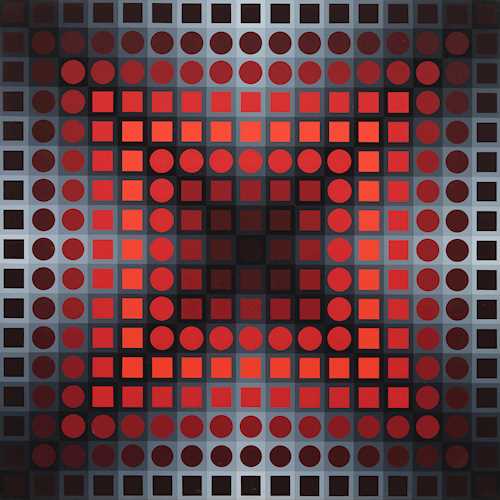
Lot 3423 - A209 PostWar & Contemporary - jeudi, 20. juin 2024, 14h00
VICTOR VASARELY
Provenance:
- Private collection, Switzerland, acquired from the above fondation in 1977.
- Private collection Switzerland, received by inhertiance.
- Auction Koller, Zurich, 7.12.2019, lot 3494.
- Private collection Switzerland, acquired from the above auction.
This work will be included in the forthcoming catalogue raisonné by the Fondation Vasarely.
"Geometry in my paintings is the source of a universe that takes life through colors". Victor Vasarely
In "Kezdi-RSZ", Victor Vasarely expertly demonstrates how the sophisticated combination of geometric shapes and the bright colours of Pop Art, together with a well-orchestrated arrangement of the elements, can alter sensory perception. With consummate skill and virtuoso precision, he generates the illusion of movement from within this static painting through the use of a colour spectrum ranging from intense red to dark brown and from shimmering silver to deep black, in order to conjure up vibrations, rotations and oscillations. As a result, Vasarely, the Op Art pioneer, not only deceives the eye, but also manipulates sensory impressions and constantly challenges the mind.
In this typical work, Victor Vasarely, both a brilliant painter and graphic artist, deftly employs geometry and mathematics as elementary building blocks. Through the precise use of geometric shapes and mathematical principles, he creates spatial effects and illusions of depth. Mathematical concepts such as repetition, symmetry and progression enable him to create an expressive composition which is both superbly structured and balanced. In the centre of the painting, he places a dark red circle on a black square, framed by eight rows, with the outermost row divided into 17 horizontally and 17 vertically arranged squares. The carefully arranged rows consist of circles or squares of the same size and in uniform colours. They are painted on squares which range from light and dark silver tones to black, forming a complex background. Viewed from a distance, the squares along the diagonals, which are consistently rendered in black, create the illusion of a St Andrew's cross, while the rather dark colour scheme in the centre and in the first row suggests an indentation. Depending on the viewer's perspective, the patterns and structures in "Kezdi-RSZ" are either transformed or distorted.
CHF 90 000 / 140 000 | (€ 92 780 / 144 330)
Vendu pour CHF 187 500 (frais inclus)
Aucune responsabilité n'est prise quant à l´exactitude de ces informations.


